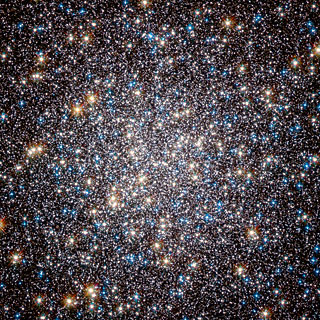Martin Pugh's image is a very fine one. Do compare it, however, with the
ESA/HEIC Hubble Picture of the Week | 2012 Jun 11, showing the Compact Blue Dwarf galaxy UGC 5497. The galaxy and the globular look extremely similar, but thanks to Martin Pugh's excellent color data we can tell that the object in his image is a globular. The brightest stars in his picture are red giants, and the very brightest and most orange of them are so called Asymptotic Giant Branch stars, which have just reached their greatest luminosity before expelling their outer atmospheres and turning into white dwarfs. There is a large number of obviously blue stars, which are fainter than the red giants but brighter than an even larger population of neutral-colored stars. The blue stars are blue horizontal branch stars, which represents an intermediate stage between "normal" red giants and Asymptotic Branch Giants in metal-poor stellar populations. The neutral-colored stars are hydrogen-fusing dwarfs at about the same temperature as the Sun.
The color information of the UGC 5497 image is poor, however, since the picture was produced from exposures through only two filters, an optical or clear one centered at 606 nm, and an infrared one centered at 814 one.
http://www.spacetelescope.org/static/ar ... w1224a.jpg wrote:
The object is a compact blue dwarf galaxy that is infused with newly formed clusters of stars. The bright, blue stars that arise in these clusters help to give the galaxy an overall bluish appearance that lasts for several million years until these fast-burning stars explode as supernovae.
If you look at a
better-resolved version of the ESA/HEIC image of UGC 5497, you can see that there really appears to be a brightish population of marginally orange stars in this dwarf galaxy as well as a number of faint blue stars. Personally I can't spot any bright blue stars at all in this object, however, and no clusters, either. I can see a few small, faint, extended, neutral-colored objects in or or next to UGC 5497 which may be emission nebulae, since they ought to be redder in color if they were background galaxies. Actually, though, I'm not sure they aren't galaxies.
We can clearly see how unfavorable the use of one clear optical filter and one infrared filter is, if you want to extract color information from a nearby, relatively dust-free object.
For another comparison, take a look at this ESA/HEIC picture of globular
cluster M53. This image, too, is made from exposures through the clear filter at 606 nm and the infrared one at 814 nm. You can see how hard it is to extract good color information from this image. There really are a number of bright orange objects in M53, but nothing in this picture looks more orange than anything in the Hubble picture of UGC 5497. If anything, the most orange stars in UGC 5497 look more orange than anything in M53, while the blue stars in M53 look every bit as blue the blue population of UGC 5497, even though the latter object is certainly bluer overall. Not that you can tell.
Thank you so much, Martin Pugh, for producing pictures with such great color information!

(By the way, don't miss Martin's picture of
the heart of M13, showing a greenish star at about 2 o'clock!)
Ann
 M13: The Great Globular Cluster in Hercules
M13: The Great Globular Cluster in Hercules